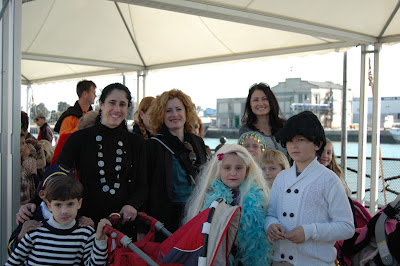 | |||
| Conejos de Nieve |
California’s Sierra Nevada was my stomping ground growing up. From the golden foothills and rolling fir-covered mountains of Angels Camp and Bear Valley to the craggy granite-strewn Desolation Wilderness where we built our cabin, the Sierra Nevada has been home, and I spent significant portions of my childhood playing in the rusty red dirt and skiing the slopes of this gorgeous range.
 |
| California's Sierra Nevada, Upper Bassi |
Imagine my surprise to find the original Sierra Nevada, not only in Spain, but practically on my doorstep! Less than four hours by car and still in Andalucía, the Sierra Nevada juts out from the surrounding plain of Granada (see post, 1/28), a massively imposing range that provides Southern Spain with excellent skiing and other mountain sports. Despite the excessive drought this winter, La Sierra Nevada, topping out at over 11,000 feet, is well-equipped to make enough snow to ski on. (In fact, it turns out that this winter is a disaster for most ski areas, including California. In Europe, La Sierra Nevada is at this point the best skiing in Europe—or so they told me.) And so, at the end of February, off we went on a fact-finding mission.
 |
| La Alhambra de Granada in front of the Sierra Nevada |
Like the rest of Spain, the Sierra Nevada went through a building boom over the last 10 years, resulting in huge vertical neighborhoods of condos and apartments built up the steep mountainside. A lift runs through the middle of this community, stopping midway so that tired skiers (and especially kids) don’t have to walk up and down in clunky ski boots. At the bottom is the main gondola to the rest of the lifts and other gondolas. High-speed quad and six-pack chairs, along with the three gondolas, make lift lines scarce even though we’d chosen a regional holiday, Dia de Andalucía, to explore the Spanish skiing culture.
 |
| Where's the snow?? |
Last year Tia and Sasha spent five days with Aunt Suzi at Mammoth Mountain in California, so they were raring to go. In beautiful sunshine, with barely any snow to be seen, we headed out to the slopes from our studio, taking the mini-lift down to the gondola.
 |
| Mid-community ski lift, how thoughtful! |
And what skiing it was! Although the last real snow had fallen in early January, the slopes were groomed and clean, with only a few rocky spots. Todd, with his rasta-dred-hat and on a snowboard, floated down the slopes, only knocking Tia over once when getting off the lift.
 |
| Hanging with Dad |
Tia, for her part, perfected her dive-bomber, poles-tucked-under-arms “Aunt Suzi” style, careening down the slopes fearlessly. Sasha advanced to the stem-christie stage, mimicking Mommy in swish-swishing down the slopes. With very few mishaps (Tia and Sasha at one point converged on a seated Todd, running over both his hands), we skied from morning to afternoon, with a lovely lunch break at our little studio, easily accessible via the community lift.
As I was told by a local, this is the only place where you can ski in the morning and hit the beach in the afternoon, as Playa Motril and its golden sands are a mere hour-and-twenty-minute drive from the slopes. Definitely a place to return to; spring skiing, anyone?
¡Viva La Sierra Nevada!
 |
| Looking down to Granada from the top (well, almost!) |












